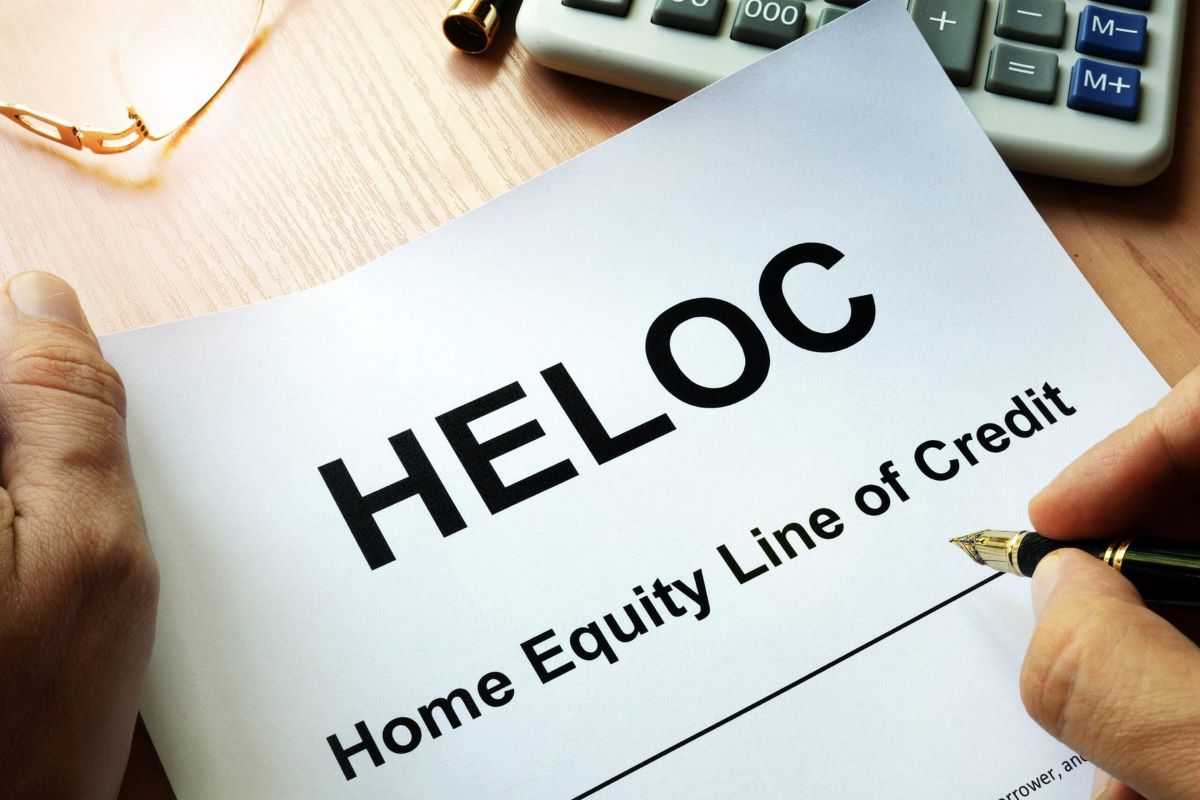Home>Finance>Home Equity Line Of Credit How Long Does It Take


Finance
Home Equity Line Of Credit How Long Does It Take
Published: January 10, 2024
Need financing for your home equity line of credit? Find out the timeline and process involved. Get your funds sooner with expert financial advice.
(Many of the links in this article redirect to a specific reviewed product. Your purchase of these products through affiliate links helps to generate commission for LiveWell, at no extra cost. Learn more)
Table of Contents
- Introduction
- What is a Home Equity Line Of Credit?
- How Long Does It Typically Take to Get a Home Equity Line Of Credit?
- Factors That Affect the Time Frame for Securing a Home Equity Line Of Credit
- Documentation Required for a Home Equity Line Of Credit Application
- Steps in the Home Equity Line Of Credit Approval Process
- Potential Delays and Challenges in Obtaining a Home Equity Line Of Credit
- Tips for Speeding Up the Home Equity Line Of Credit Process
- Conclusion
Introduction
Home equity line of credit (HELOC) has become a popular financial instrument for homeowners looking to access the equity in their properties. It allows individuals to borrow against the value of their homes, using it as collateral. This flexible line of credit gives homeowners the freedom to use the funds for various purposes, such as home renovations, debt consolidation, or emergency expenses.
However, one important consideration for individuals interested in obtaining a home equity line of credit is the amount of time it takes to secure the funds. The timeline for getting approved for a HELOC can vary depending on several factors, including the lender’s processes, the applicant’s financial situation, and the required documentation.
In this article, we will explore the timeline for obtaining a home equity line of credit and the factors that can influence the process. We will also discuss the documentation required and provide some tips for speeding up the approval process. By understanding the typical timeframe and the steps involved, homeowners can better plan and manage their financial goals.
What is a Home Equity Line Of Credit?
A home equity line of credit (HELOC) is a type of loan that allows homeowners to borrow against the equity in their homes. It is a revolving line of credit, similar to a credit card, where borrowers can withdraw funds as needed, up to a predetermined limit. The amount that can be borrowed is typically based on a percentage of the home’s appraised value, minus any outstanding mortgage balance.
Unlike a traditional loan, where borrowers receive a lump sum of money upfront, a HELOC provides homeowners with the flexibility to access funds as necessary. This is especially appealing to individuals who have ongoing or fluctuating financial needs. They can borrow funds when needed and only pay interest on the amount they use.
One of the significant advantages of a home equity line of credit is its versatility. The funds can be used for a wide range of purposes, including home improvements, education expenses, medical bills, or even investment opportunities. Additionally, the interest paid on a HELOC may be tax-deductible, making it an attractive option for some homeowners.
It is important to note that a home equity line of credit differs from a home equity loan. With a home equity loan, borrowers receive a lump sum of money upfront and repay it over a fixed term. In contrast, a HELOC provides a revolving line of credit that can be accessed over an extended period of time.
Understanding the basics of a home equity line of credit is important for homeowners considering this financial tool. By leveraging the equity in their homes, they can gain access to funds for various needs while potentially enjoying tax benefits and the flexibility of a revolving credit line.
How Long Does It Typically Take to Get a Home Equity Line Of Credit?
The timeline for obtaining a home equity line of credit (HELOC) can vary depending on several factors. On average, the process can take anywhere from 2 to 6 weeks, but it can take longer in certain circumstances. It’s important to keep in mind that each lender may have different processing times, so it’s always a good idea to inquire about their specific timeline.
One of the primary factors that can impact the timeframe is the efficiency of the applicant in providing the necessary documentation. To expedite the process, homeowners should gather all required paperwork before applying for a HELOC. This way, they can submit the documentation promptly, reducing any potential delays.
The lender’s internal processes and workload can also influence the timeline. Some financial institutions are more streamlined and can process applications more quickly, while others may have more extensive review procedures in place. It’s essential to research and choose a lender with a reputation for efficient processing.
Another crucial factor that affects the timeline is the borrower’s financial situation and creditworthiness. Lenders will assess the applicant’s income, credit score, debt-to-income ratio, and other financial factors. It’s important for homeowners to have a good financial track record and a favorable credit score to increase their chances of a faster approval process.
Additionally, the complexity of the home equity line of credit application can impact the timeline. If the loan request involves multiple properties, co-borrowers, or additional documentation requirements, it may require additional time for underwriting and approval.
Overall, homeowners should anticipate a 2 to 6 week timeframe to secure a home equity line of credit. Being prepared, choosing a reputable lender, and having a strong financial profile can help expedite the process. It’s always recommended to consult with a financial advisor or mortgage professional to gain a better understanding of the specific timeline and requirements.
Factors That Affect the Time Frame for Securing a Home Equity Line Of Credit
There are several key factors that can influence the time frame for securing a home equity line of credit (HELOC). Understanding these factors can help homeowners anticipate and navigate the application process more effectively.
1. Lender’s Processes: Each lender may have their own internal processes and procedures for reviewing and approving HELOC applications. Some lenders may have more streamlined operations, allowing for faster processing times, while others may have more extensive review processes that can result in longer wait times.
2. Documentation Requirements: The documentation required for a HELOC application can vary depending on the lender and the borrower’s unique circumstances. Providing all the necessary documents in a timely manner is crucial for a smooth and efficient application process. Delays can occur if the borrower fails to provide all the required paperwork or if there are complications in verifying the information provided.
3. Financial Profile: The borrower’s financial profile plays a significant role in the time frame for obtaining a HELOC. Lenders will assess factors such as credit score, income, employment history, debt-to-income ratio, and other financial obligations. A strong financial profile with a good credit score and a stable income can expedite the approval process.
4. Valuation of the Property: The lender will typically require an appraisal to determine the value of the property. The time required for the appraisal can vary depending on the availability of appraisers and the complexity of the property. In some cases, delays in the appraisal process can prolong the overall time frame for securing a HELOC.
5. Loan Amount and Equity: The amount of money being requested through the HELOC and the level of equity in the property can also impact the timeline. Higher loan amounts or lower levels of equity may require more rigorous review and assessment by the lender, which can result in a longer processing time.
6. Underwriting and Approval Process: Once all the necessary documentation has been submitted, the lender will undertake a rigorous underwriting process. This involves assessing the borrower’s financial information, reviewing the collateral (the property), and making a final decision on approval. The time required for underwriting can vary depending on the complexity of the application and the lender’s workload.
It’s important to keep in mind that while these factors can influence the time frame, proactive communication with the lender and ensuring timely submission of documents can help expedite the process. Working with a knowledgeable mortgage professional can also provide guidance and support throughout the application process.
Documentation Required for a Home Equity Line Of Credit Application
When applying for a home equity line of credit (HELOC), borrowers are required to provide certain documentation to support their loan application. The specific documentation needed may vary depending on the lender’s requirements and the borrower’s unique circumstances. However, here are some common documents that are typically requested:
1. Proof of Identity: Borrowers will likely need to provide a valid form of identification, such as a driver’s license, passport, or government-issued ID.
2. Proof of Income: Lenders will require proof of income to assess the borrower’s ability to repay the loan. This can include recent pay stubs, W-2 forms, or tax returns for self-employed individuals.
3. Proof of Employment: Borrowers may need to provide documentation to verify their current employment status, such as an employment verification letter or recent pay stubs showing the employer’s name and contact information.
4. Property Documentation: Lenders will typically require documentation relating to the property being used as collateral for the HELOC. This can include a copy of the deed or the title, as well as recent property tax statements.
5. Mortgage Statements: If there is an existing mortgage on the property, borrowers will need to provide mortgage statements to verify the outstanding balance and payment history.
6. Homeowners Insurance: Lenders will require proof of homeowners insurance to protect their interest in the property. Borrowers will need to provide a copy of their insurance policy or documentation from their insurance provider.
7. Bank Statements: Lenders may request recent bank statements to verify the borrower’s financial stability and assess their ability to manage the line of credit. These statements should typically cover the past few months.
8. Credit Information: Borrowers should expect the lender to run a credit check during the application process. While this is not a document that the borrower needs to provide, it is important to ensure that the credit information is accurate and up-to-date.
It is crucial for borrowers to consult with their lender or loan officer to get a complete list of the required documentation. Having all the necessary paperwork prepared and organized ahead of time can help streamline the application process and potentially reduce any delays in approval.
Steps in the Home Equity Line Of Credit Approval Process
The process of obtaining approval for a home equity line of credit (HELOC) involves several key steps. While the specific sequence and requirements may vary depending on the lender, here is a general outline of the typical approval process:
1. Application: The first step is to submit an application for a HELOC. This involves providing personal and financial information, including details about the property being used as collateral, the desired loan amount, and the purpose of the funds. The lender will also typically run a credit check during this stage.
2. Documentation Submission: Once the application is submitted, the borrower will need to provide the required documentation outlined by the lender. This includes proof of identity, income verification, property documentation, mortgage statements, homeowners insurance, and any additional documents specific to the lender’s requirements.
3. Property Appraisal: The lender will typically order an appraisal of the property to determine its current market value. An appraiser will visit the property and assess its condition and features. The appraisal is crucial as it helps determine the maximum amount the borrower can borrow based on the property’s value and the lender’s loan-to-value ratio requirements.
4. Underwriting: Once the application and documentation are complete, the lender will initiate the underwriting process. During underwriting, the lender will carefully review the borrower’s financial information, credit history, property appraisal, and any other relevant factors. The goal is to assess the borrower’s creditworthiness and evaluate the risk associated with approving the HELOC.
5. Approval or Denial: After the underwriting review, the lender will make a decision on whether to approve or deny the HELOC application. If approved, the lender will provide the borrower with a commitment letter outlining the terms and conditions of the line of credit. If denied, the lender will typically provide an explanation for the decision.
6. Closing and Funding: If the HELOC application is approved, the next step is closing and funding the loan. The borrower will need to review and sign the loan documents, including the promissory note, disclosure statements, and any other necessary paperwork. The lender will then disburse the funds, either as a lump sum or in the form of a credit line, depending on the borrower’s preference.
It’s important to note that some lenders may require additional steps or have specific procedures in place. Therefore, it’s always recommended to consult with the lender or a loan officer to get a comprehensive understanding of their specific approval process. Following the lender’s instructions and providing all necessary information promptly can help expedite the approval process and ensure a smooth transition to accessing the home equity line of credit.
Potential Delays and Challenges in Obtaining a Home Equity Line Of Credit
While securing a home equity line of credit (HELOC) can be a valuable financial tool, there are potential delays and challenges that borrowers may encounter during the application process. Being aware of these challenges can help homeowners better navigate the process and manage their expectations.
1. Documentation Requirements: One of the common challenges is gathering and submitting the required documentation. If borrowers are unprepared or have difficulty retrieving the necessary paperwork, it can significantly delay the application process.
2. Appraisal Delays: The appraisal process, which determines the value of the property being used as collateral, can occasionally face delays. Factors such as the availability of appraisers, complexity of the property, or even unforeseen circumstances can prolong the time frame.
3. Financial Qualifications: Lenders carefully scrutinize the borrower’s financial profile, including credit score, income, and debt-to-income ratio. If the borrower has a less than satisfactory credit history or unstable income, it can result in a longer approval process or potential denial of the application.
4. Property Liens or Title Issues: In some cases, issues related to property liens or title discrepancies can arise during the application process. These issues typically need to be resolved before the HELOC can be approved and funded, leading to delays and additional paperwork.
5. Loan Amount and Equity: Higher loan amounts or lower levels of equity in the property may require additional review and assessment by the lender. This can result in a longer processing time as the lender evaluates the borrower’s risk and determines the terms of the HELOC.
6. Changes in Financial Circumstances: If there are significant changes in the borrower’s financial circumstances during the application process, such as a job loss or a decline in credit score, it can impact the lender’s decision or result in additional requirements and delays.
7. Lender’s Workload: The lender’s workload and internal processes can also impact the timeline. If the lender is experiencing a high volume of applications or has limited resources, it could lead to delays in processing and approval.
To minimize potential delays and challenges, borrowers should be prepared, organized, and proactive in providing all required documentation. Regular communication with the lender and addressing any concerns or issues promptly can help streamline the process.
It’s also essential to work with a reputable lender or mortgage professional who can guide the borrower through the process, answer questions, and provide support in overcoming any challenges that may arise.
Tips for Speeding Up the Home Equity Line Of Credit Process
While the timeline for obtaining a home equity line of credit (HELOC) can depend on various factors, there are several tips that homeowners can follow to potentially speed up the application and approval process:
1. Gather and Organize Documentation: Before starting the application process, gather all the necessary documentation, such as proof of income, identification, property documentation, and any other requested paperwork. Keeping everything organized and readily available can help expedite the process.
2. Ensure Accurate and Updated Credit Information: Review your credit report and ensure that all the information is accurate and up-to-date. Dispute any errors or discrepancies promptly to avoid any delays in the approval process.
3. Maintain a Strong Financial Profile: Lenders assess your financial stability and creditworthiness when evaluating your HELOC application. Pay your bills on time, avoid taking on excessive debt, and maintain a low credit utilization ratio to present a strong financial profile to lenders.
4. Respond Promptly and Cooperate with the Lender: Respond promptly to any requests or inquiries from the lender. Cooperate with them and provide any additional information or documents they may need in a timely manner. This proactive approach can help prevent unnecessary delays.
5. Choose a Lender with Efficient Processes: Research lenders and choose one with a reputation for efficient and streamlined processes. This can help ensure a smoother and faster approval process for your HELOC application.
6. Communicate Openly with the Lender: Maintain open and clear communication with the lender throughout the process. If you have any questions or concerns, don’t hesitate to reach out to them for clarification. This collaborative approach can help address any potential issues and keep the process on track.
7. Work with a Mortgage Professional: Consider working with a mortgage professional who specializes in home equity lines of credit. They can guide you through the process, provide expert advice, and help navigate any challenges that may arise.
8. Be Realistic with Expectations: While following these tips can help speed up the process, it’s important to set realistic expectations. The timeframe for securing a HELOC can still vary depending on individual circumstances and the lender’s processes. Having patience and staying proactive can help ensure a smoother and more efficient experience.
By implementing these tips, homeowners can potentially expedite the home equity line of credit process and gain access to the funds they need more quickly. However, it’s important to prioritize thoroughness and accuracy to ensure a successful and well-informed financial decision.
Conclusion
A home equity line of credit (HELOC) can be a valuable financial tool that allows homeowners to tap into the equity in their properties. Whether it’s for home improvements, debt consolidation, or other financial needs, a HELOC offers flexibility and convenience. However, the time frame for securing a HELOC can vary depending on several factors. Understanding the process and taking proactive steps can help homeowners navigate the application and approval process more efficiently.
From gathering the necessary documentation to maintaining a strong financial profile, there are ways to potentially speed up the HELOC process. Being prepared, organized, and responsive to the lender’s requests can help prevent unnecessary delays. Choosing a lender with efficient processes and working with a mortgage professional can also further streamline the process.
It’s important to remember that while expediting the timeline is desirable, thoroughness and accuracy should not be compromised. Taking the time to present a complete and accurate application will increase the chances of a successful and smooth approval process.
In the end, homeowners should consult with professionals, such as mortgage advisors or loan officers, to fully understand the timeline and requirements specific to their situation. By doing so, they can make informed decisions, access the funds they need, and leverage their home equity wisely.
Overall, the HELOC process may take anywhere from a couple of weeks to a couple of months. By staying proactive, adhering to the lender’s requests, and maintaining clear communication, homeowners can navigate the process efficiently and reap the benefits of a home equity line of credit.














